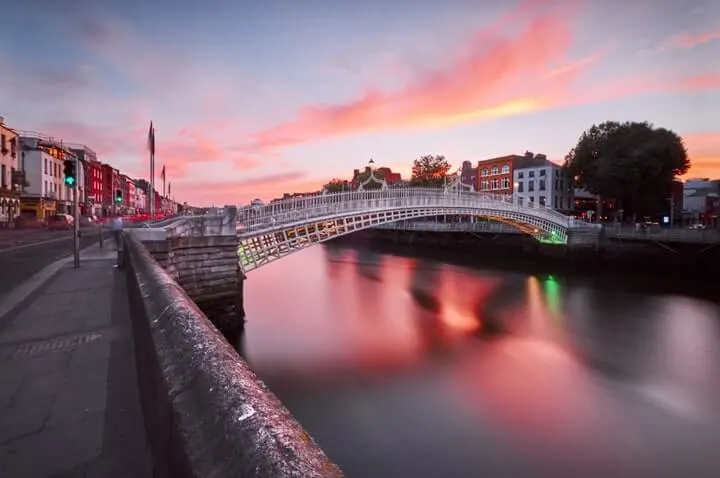A visit to the GPO museum (General Post Office) is arguably one of the best things to do in Dublin.
Immerse yourself in modern Irish history, and discover the story behind this magnificent neo-classical façade and its towering statues.
Visit the famous GPO in Dublin and uncover how it played a key role in the 1916 Easter Rising, and see for yourself the Proclamation of the Irish Republic.
Below, you’ll find info on the GPO 1916 tour, the history of the building itself along with why we believe this is one of the finest museums in Dublin.
Some quick need-to-knows about the GPO 1916 exhibition

Photo by David Soanes (Shutterstock)
Although a visit to the GPO museum is fairly straightforward, there are a few need-to-knows that’ll make your visit that bit more enjoyable.
1. Location
The GPO is situated just over the River Liffey, on the northern banks of the city centre. Cross over O’Connell Bridge, and it’s a quick 5-minute walk along O’Connell Street Lower. It’s a short ramble from the likes of Trinity College, Temple Bar and the Molly Malone Statue.
2. Opening Hours
The GPO museum is open Wednesday to Saturday, from 10:00am – 5:00pm (last admission at 4:00pm). During July, August, and September the GPO 1916 tour runs on Tuesdays at standard times. Get the most up-to-date opening hours here.
3. Admission
Ticket prices (affiliate link) for the GPO museum vary from €15.00 for adults to €7.50 for kids. For those 65+, there’s a senior ticket for €12.00.
4. GPO Tour
The GPO Witness History is a self-guide experience with a one-way system in place. Tours are available, but only for groups at present, and must be booked via the reservations department. However, there is an excellent audio guide available at no extra charge. More below.
5. Still a working post office
The GPO remains a working post office, with around 900 people reported to be working in the building in 2022. The stunning building houses the Irish postal service, and you’ll see tellers at work before you start your tour.
A brief history of the GPO

Photo left: Shutterstock. Right: The Irish Road Trip
The GPO’s current location is actually its 6th. Previous locations include Fishamble Street (1689), Sycamore Alley (1709) and Bardin’s Chocolate House (1755).
The construction of the current GPO in Dublin started in 1814. It was opened 4 years later, in 1818, and that’s where the story all begins.
Architecture
At a cost of between £50,000-£80,000 for its construction, featuring Portland stone and mountain granite, the GPO is Dublin architecture at its best.
With an iconic neo-classical portico with six immense Ionic columns, the entrance to the GPO is steeped in a mixture of classical Greek and Irish mythology with statues of Mercury, Hecate, and Hibernia.
Located in the centre of the building is a sculpture by Oliver Sheppard depicting the death of Cú Chulainn, a mythical Irish hero.
1916 Easter Rising
However, it was during the 1916 Easter Rising that the GPO became enshrined in modern history. The building served as the headquarters for the Irish leaders, and it was outside this location that Patrick Pearse read out the Proclamation of the Irish Republic.
During the rebellion, the interior of the building was destroyed, leaving only the granite façade. The interior was rebuilt in 1929, and there is a copy of the proclamation displayed in the museum.
Present day
The original GPO museum was closed in 2015 and reopened in March 2016 as a new visitor centre and the home of the ‘GPO Witness History’.
The building is still considered to be a potent symbol of Irish nationalism and a poignant reminder of independence. In 2003 the Spire of Dublin was erected nearby, replacing Nelson’s Pillar, which was destroyed in an explosion in 1966.
What to expect from a tour of the GPO 1916 museum
A visit to the GPO 1916 museum really is a fine way to spend a few hours, especially if you’re looking for things to do in Dublin when it’s raining.
Below, you’ll find info on what to expect from a visit to the GPO in Dublin, from the immersive displays to the award-winning experience.
1. An immersive experience

Photos by The Irish Road Trip
The GPO 1916 Museum offers an engaging, immersive and interactive experience that’ll appeal to both young and old (you can book tickets here).
Those that visit will discover the story of what happened in the city during the 1916 Easter Rising and the events that led up to it.
You start the GPO tour on the upper floor of the General Post Office, where workers come and go and light shines in through beautiful windows.
From here, you descend into what feels like a basement level, and that’s where the adventure begins, and you feel like you enter a battlefield.
2. An insight into modern Irish history

Photos by The Irish Road Trip
The GPO 1916 museum is incredibly immersive. After leaving the bright post office, you descend into a dark museum (see photos above).
All around you you can hear the sounds of the interactive displays, with bullets ringing out in the distance from videos that brilliantly show what happened during 1916.
You can walk around on the GPO tour and read the various plaques and information notices, or you can sit down and watch a wonderfully put-together video.
Things to see near the GPO museum
One of the beauties of the GPO museum is that it’s a short spin away from many of the best places to visit in Dublin, like 14 Henrietta Street.
Below, you’ll find a handful of things to see and do a stone’s throw from the GPO 1916 tour (plus places to eat and where to grab a post-adventure pint!).
1. The Spire (1-minute walk)

Photos via Shutterstock
Less than 30 metres away is the Spire of Dublin or Monument of Light, as it’s also known, is made of stainless steel and stretches 120 metres into the Dublin skyline. Akin to a giant sewing needle, this staggering and yet elegant monument reflects the changing light throughout the day.
2. The O’Connell Monument (3-minute walk)

Photo left: Balky79. Photo right: David Soanes (Shutterstock)
Head back towards the river along O’Connell Street Upper, and you’ll arrive at the O’Connell Monument. The statue was completed in 1883, featuring the imposing figure of Daniel O’Connell – acknowledging his significant role in the emancipation of Irish Catholics as an abolitionist and his support for tenant farmers.
3. The Ha’penny Bridge (5-minute walk)

Photo by Bernd Meissner (Shutterstock)
Walk along the river and you’ll reach the Ha’penny Bridge, or officially the ‘Liffey Bridge’. Built in 1816, it is a pedestrian bridge made from cast iron, and the name comes from the fee charged to anyone using it to cross the river.
FAQs about the GPO 1916 museum
We’ve had a lot of questions over the years asking about everything from ‘What is the GPO in Ireland?’ (it’s a post office and museum) to ‘How many people visit the GPO every year?’ (around 300,000).
In the section below, we’ve popped in the most FAQs that we’ve received. If you have a question that we haven’t tackled, ask away in the comments section below.
How long is the GPO tour?
You’ll want to allow at least 45 minutes to get around the GPO 1916 museum. The GPO tour is self-guided, so you can spend as little or as long as you wish.
Is the museum in the GPO in Dublin worth visiting?
The GPO 1916 exhibition is excellent. It’s an immersive experience that packs a punch. The story of this turbulent time is brilliantly told via interactive displays.
How much is it in to the GPO visitor centre?
A visit to the GPO 1916 museum costs €15.00 for adults and €7.50 for kids. For those 65+, there’s a senior ticket for €12.00. There’s also a Family ticket (2+2) for €33.00.
